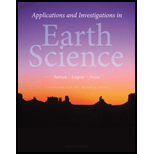
a.
To label:
The features of plate boundaries.
Introduction:
The rapid movement of the plates leads to the formation of earthquakes and volcanoes. It has been observed that most of the physical changes in the earth’s crust are due to these plates. The volcanoes and earthquakes are found at the edge of plates. These types of plates are called a plate boundary.
b.
To determine:
The type of plate boundary represented in the figure.
Introduction:
The plate boundaries are of three different types. These are convergent, divergent and transformed. The plate boundaries in which two plates move away from each other are known as divergent boundaries. The plate boundaries in which two plates move together is known as convergent boundaries. A transform boundary is formed when the two plates slide by each other. The distance between the plates remains the same.
Want to see the full answer?
Check out a sample textbook solution
Chapter 7 Solutions
Applications and Investigations in Earth Science (8th Edition)
- Connecticut is the only state in America where treated industrial and municipal wastewater cannot be discharged to a surface water body used downstream as a source of drinking water. It is legal in all 49 other states. For example, New Orleans, Louisiana takes its drinking water from the Mississippi River which receives discharges of many, many treated municipal and industrial wastewater discharges as well as agricultural runoff from the more than 20 states that are upstream of it. Should other states be required to adopt Connecticut's standard? Whyarrow_forwardWhat is thermal pollution? How can it be controlled?arrow_forwardhow can the addition of nutrients such as nitrates and phosphates result in a reduction of the amount of dissolved oxygen in the water?arrow_forward
- Congratulations! You have just been selected to be the ruler of China with absolute power! What are the first five things that you would do to protect the environment and human health from water pollution (not other types of pollution)?arrow_forwardWhy is storm water management more of a problem in an urban area than in a rural area?arrow_forwardwhat is biochemical oxygen demand? how is it related to water quality?arrow_forward
- How are most industrial wastes disposed of? How has this changed over the past 25 years?arrow_forwardThink about natural resource management topics. Which topic or topics, are most interesting?arrow_forwardThink about natural resource management topics. Which topic or topics, if any, are of most interest to you?arrow_forward
 Applications and Investigations in Earth Science ...Earth ScienceISBN:9780134746241Author:Edward J. Tarbuck, Frederick K. Lutgens, Dennis G. TasaPublisher:PEARSON
Applications and Investigations in Earth Science ...Earth ScienceISBN:9780134746241Author:Edward J. Tarbuck, Frederick K. Lutgens, Dennis G. TasaPublisher:PEARSON Exercises for Weather & Climate (9th Edition)Earth ScienceISBN:9780134041360Author:Greg CarbonePublisher:PEARSON
Exercises for Weather & Climate (9th Edition)Earth ScienceISBN:9780134041360Author:Greg CarbonePublisher:PEARSON Environmental ScienceEarth ScienceISBN:9781260153125Author:William P Cunningham Prof., Mary Ann Cunningham ProfessorPublisher:McGraw-Hill Education
Environmental ScienceEarth ScienceISBN:9781260153125Author:William P Cunningham Prof., Mary Ann Cunningham ProfessorPublisher:McGraw-Hill Education Earth Science (15th Edition)Earth ScienceISBN:9780134543536Author:Edward J. Tarbuck, Frederick K. Lutgens, Dennis G. TasaPublisher:PEARSON
Earth Science (15th Edition)Earth ScienceISBN:9780134543536Author:Edward J. Tarbuck, Frederick K. Lutgens, Dennis G. TasaPublisher:PEARSON Environmental Science (MindTap Course List)Earth ScienceISBN:9781337569613Author:G. Tyler Miller, Scott SpoolmanPublisher:Cengage Learning
Environmental Science (MindTap Course List)Earth ScienceISBN:9781337569613Author:G. Tyler Miller, Scott SpoolmanPublisher:Cengage Learning Physical GeologyEarth ScienceISBN:9781259916823Author:Plummer, Charles C., CARLSON, Diane H., Hammersley, LisaPublisher:Mcgraw-hill Education,
Physical GeologyEarth ScienceISBN:9781259916823Author:Plummer, Charles C., CARLSON, Diane H., Hammersley, LisaPublisher:Mcgraw-hill Education,





